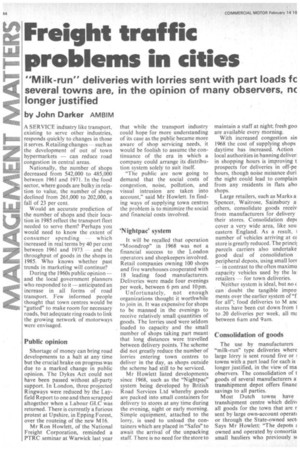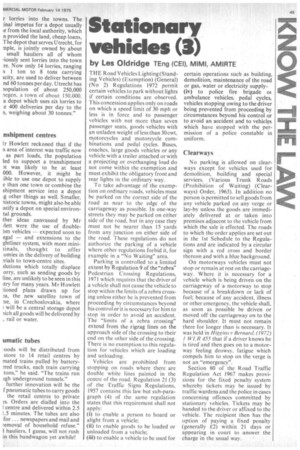Freight traffic problems in cities
Page 46

Page 47

If you've noticed an error in this article please click here to report it so we can fix it.
"Milk-run" deliveries with lorries sent with part loads fc several towns are, in the opinion of many observers nc longer justified
by John Darker AMBIM A SERVICE industry like transport, existing to serve other industries, responds quickly to changes in those it serves. Retailing changes — such as the development of out of town hypermarkets — can reduce road congestion in central areas.
Nationally, the number of shops decreased from 542,000 to 485,000 between 1961 and 1971. In the food sector, where goods are bulky in relation to value, the number of shops declined from 261,000 to 202,000, a fall of 23 per cent.
Would an accurate prediction of the number of shops and their location in 1985 reflect the transport fleet needed to serve them'? Perhaps you would need to know the extent of consumer spending which increased in real terms by 40 per cent between 1961 and 1973 — and the throughput of goods in the shops in 1985. Who knows whether past trends in marketing will continue?
During the 1960s public opinion — and the local government planners who responded to it -anticipated an increase in all forms of road transport. Few informed people thought that town centres would be "gutted" to make room for necessary roads, but adequate ring roads to link the growing network of motorways were envisaged.
Public opinion
Shortage of money can bring road developments to a halt at any time but the crucial brake on progress was due to a marked change in public opinion. The Dykes Act could not have been passed without all-party support. In London, three projected Ringways were reduced by the Layfield Report to one and then scrapped altogether when a Labour GLC was returned. There is currently a furious protest at Upshire, in Epping Forest, over the routeing of the new M16.
Mr Ron Howlett, of the National Freight Corporation, reminded a PTRC seminar at Warwick last year that while the transport industry could hope for more understanding of its case as the public became more aware of shop servicing needs, it would be foolish to assume the continuance of the era in which a company could arrange its distribution system solely to suit itself.
"The public are now going to demand that the social costs of congestion, noise, pollution, and visual intrusion are taken into account," said Mr Howlett. In finding ways of supplying town centres the problem is to minimize the social and financial costs involved.
'Nightpac' system
It will be recalled that operation "Moondrop" in 1968 was not a financial success to . the London operators and shopkeepers involved. Retail companies owning 100 shops and five warehouses cooperated with 18 leading food manufacturers. Deliveries were made four evenings per week, between 6 pm and Wpm..
Unfortunately, not enough organizations thought it worthwhile to join in. It was expensive for shops to be manned in the evenings to receive relatively small quantities of goods. The lorries used were seldom loaded to capacity and the small number of shops taking part meant that long distances were travelled between delivery points. The scheme did not greatly reduce the number of lorries entering town centres to deliver in the day, as shops outside the scheme had still to be serviced.
Mr Howlett listed developments since 1968, such as the "Nightpac" system being developed by British Road Services Ltd whereby goods are packed into small containers for delivery to stores at any time during the evening, night or early morning. Simple equipment, attached to the lorry, is used to unload the containers which are placed in "Safes" to await the arrival of the unpacking staff. There is no need for the store to maintain a staff at night; fresh goo are available every morning.
With increased congestion sin 1968 the cost of supplying shops daytime has increased. Action local authorities in banning deliveri in shopping hours is improving t prospects for deliveries in off-pe hours, though noise nuisance duni the night could lead to complain from any, residents in flats abo shops.
Large retailers, such as Marks a: Spencer, Waitrose, Sainsbury a. others, consolidate goods receiv from manufacturers for delivery their stores. Consolidation depc cover a very wide area, like sou eastern England. As a result, 1 number of vehicles arriving at eg store is greatly reduced. The princii parcels carriers also undertake good deal of consolidation peripheral depots, using small !art in contrast to the often maximu capacity vehicles used by the lai retailers — for town deliveries.
Neither system is ideal, but no c can doubt the tangible impro. rnents over the earlier system of "f for all"; food deliveries to M anc stores have been cut down from 1 to , 20 deliveries per week, allbetween 6arn and 9am.
Consolidation of goods
The use by manufacturers "milk-run" type deliveries where large Icirry is sent round five or towns with a part load for each is longer justified, in the view of ma observers. The consolidation of t goods of several manufacturers a. transhipment depot offers financ savings to all parties.
Most Dutch towns have transhipment centre which deliv, all goods for the town that are r sent by large own-account operatr or through the State-owned sect, Says Mr Howlett "The _depots I owned and operated by consortia small hauliers who previously st r lorries into the towns. The inal impetus for a depot usually Le from the local authority, which n provided the land, cheap loans, The depot that serves Utrecht, for /vie, is jointly owned by about small hauliers all of whom tiously sent lorries into the town re. Now only 14 lorries, ranging n 1 ton to 8 tons carrying lefty, are used to deliver between nd 60 tonnes per day. Utrecht has 3opulation of about 250,000 legen, a town of about 150,000, a depot which uses six lorries to .e 400 deliveries per day to the n, weighing about 30 tonnes."
nshipment centres
Er Howlett reckoned that if the n area of interest was traffic now as part loads, the population led to support a transhipment )t was likely to be at least 000. However, it might be ible to use one depot to supply e than one town or combine the shipment service into a depot s other things as well. Smaller. 1istoric towns, might also be able istify a depot on special environtal grounds.
ther ideas canvassed by Mr /lett were the use of doublebm vehicles — expected soon to egal — and extensions to the ghtliner system, with more minifinals, thought to offer omies in the delivery of building :rials to town-centre sites.
Autions which totally displace orry, such as sending goods by line, are unlikely to be seen in this itry for many years. Mr Howlett tioned plans drawn up for the new satellite town of ue, in Czechoslovakia, where will be a central storage depot lich all goods will be delivered by , rail or water.
umatic tubes
,00ds will be distributed from store to 14 retail centres by mated trains pulled by battery!red trucks, each train carrying tons," he said. "The trains run igh underground tunnels."
• further innovation will be the f pneumatic tubes to carry goods the retail centres to private !s. Orders are dialled into the I centre and delivered within 2.5 I.5 minutes. The tubes are also for. . newspapers and mail and removal of household refuse." 1 hauliers, I guess, will not rush in this bandwagon yet awhile!




































































































